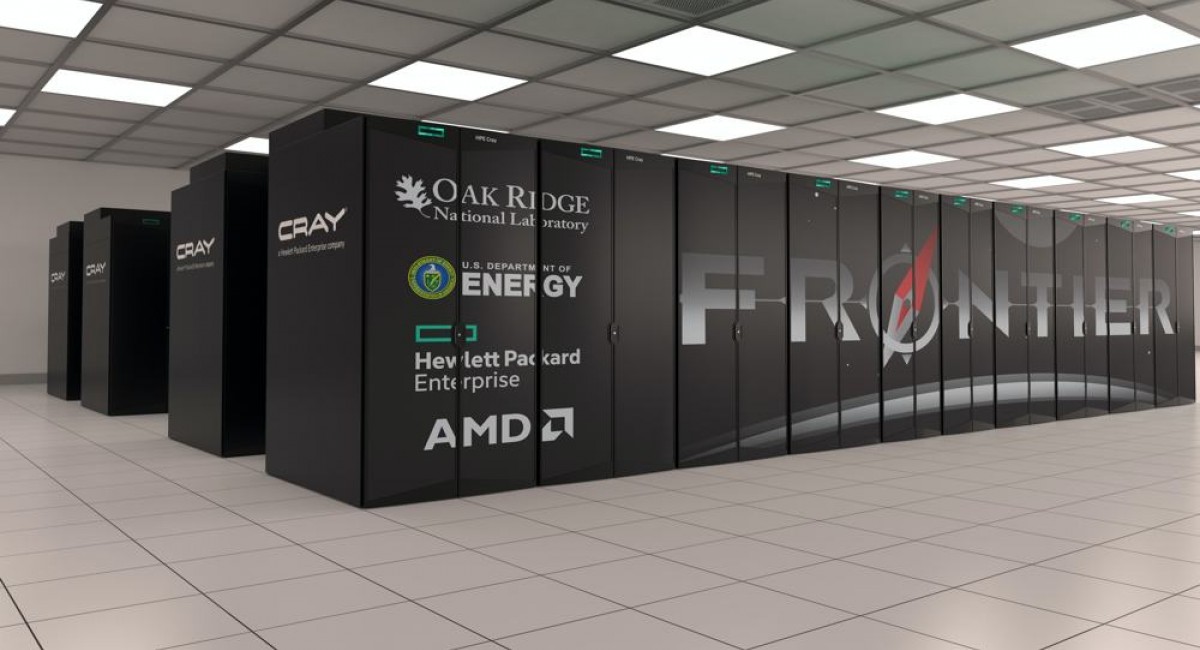SEARCH
Frontier is the world's first and fastest exascale supercomputer by HPE

SHARE IT
Hewlett Packard Enterprise announced that Frontier, a new supercomputer that HPE built for the U.S. Department of Energy’s Oak Ridge National Laboratory (ORNL), has reached 1.1 exaflops, making it the world’s first supercomputer to break the exascale speed barrier, and the world’s fastest supercomputer, according to the Top500 list of world’s most powerful supercomputers.
Frontier also ranked number one in a category, called mixed-precision computing, that rates performance in formats commonly used for artificial intelligence, with a performance of 6.88 exaflops. Additionally, the new supercomputer claimed the number one spot on the Green500 list as the world’s most energy efficient supercomputer with 52.23 gigaflops performance per watt, making it 32% more energy efficient compared to the previous number one system3
In addition to Frontier, three more HPE-built systems are named to the top 10 of the Top500 list, including the LUMI supercomputer for the CSC – IT Center for Science in Finland at number three, Perlmutter supercomputer for the U.S. Department of Energy’s National Energy Research Scientific Computing Center (NERSC) at number seven, and the Adastra supercomputer for GENCI-CINES at number ten
ORNL’s Frontier to solve problems that are 8X more complex, up to 10X faster
As the most powerful supercomputer in the world, delivering unprecedented performance and advanced capabilities, Frontier will speed up discoveries, make breakthroughs, and address the world’s toughest challenges. The supercomputer, which is more powerful than the next top seven of the world’s largest supercomputers, will allow scientists to model and simulate at an exascale level to solve problems that are 8X more complex, up to 10X faster.2 Frontier is also expected to reach even higher levels of speed with a theoretical peak performance of 2 exaflops.
The supercomputer will have significant impact in critical areas such as cancer and disease diagnosis and prognosis, drug discovery, renewable energy, and new materials to create safer and sustainable products.
Justin Hotard, executive vice president and general manager, HPC & AI, at HPE, said:
Today’s debut of the Frontier exascale supercomputer delivers a breakthrough of speed and performance, and will give us the opportunity to answer questions we never knew to ask. Frontier is a first-of-its-kind system that was envisioned by technologists, scientists and researchers to unleash a new level of capability to deliver open science, AI and other breakthroughs, that will benefit humanity. We are proud of this moment, which continues the United States’ leadership in supercomputing, now including exascale, made possible by the ongoing public and private partnership between the U.S. Department of Energy, Oak Ridge National Laboratory, HPE, and AMD.
Frontier ushers in a new era of scientific discovery and engineering breakthroughs at exascale speed
Frontier is built with HPE Cray EX supercomputers that deliver end-to-end capabilities comprised of compute, accelerated compute, software, storage and networking to support the magnitude of exascale performance.
The new exascale supercomputer, which is more powerful than the world’s next seven largest supercomputers combined, is dedicated to open science, allowing researchers, scientists, and engineers from a variety of public and private institutions, to leverage Frontier.
In addition to modeling and simulating complex scientific research, across biological, physical and chemical sciences, with higher resolution, Frontier will also enable dramatic breakthroughs in AI. At an exascale speed, Frontier’s users can develop AI models that are 4.5X faster and 8X larger, allowing to train more data that can increase predictability and speed time-to-discovery.
Inside Frontier: A technological phenomenon
HPE designed and built Frontier with the following state-of-the-art technologies, delivered through the HPE Cray EX supercomputers, to offer dramatically higher performance to model and simulate at a new level, and target new applications in AI and machine learning to increase accuracy faster and more efficiently:
- 74 HPE Cray EX cabinets each weighing more than 8,000 lbs. Each node contains one optimized 3rd Gen AMD EPYC processor and four AMD Instinct MI250x accelerators, for a total of 9,408 CPUs and 37,632 GPUs in the entire system
- 90 miles worth of HPE Slingshot networking cables, which delivers the world’s only high-performance Ethernet fabric designed for next-generation HPC and AI solutions. These include larger, data-intensive workloads, to address demands for higher speed and congestion control for applications to run smoothly and boost performance.
- Cray Clusterstor E1000 storage system, which enables Frontier’s Orion storage system to deliver 700 petabytes of storage capacity, peak write speeds of more than 35 terabytes per second, and more than 15 billion random-read input/output operations per second.
- Sophisticated liquid-cooling capabilities that also promotes a quieter datacenter, compared to a noisier, air-cooled system, to efficiently remove heat from high power devices such as processors, GPUs and switches, through an auxiliary Cooling Distribution Unit (CDU).
In addition to Frontier, HPE is also delivering exascale supercomputers to the U.S. Department of Energy’s Argonne National Laboratory and Lawrence Livermore National Laboratory.
To learn more about Frontier, please visit: https://www.olcf.ornl.gov/frontier/
MORE NEWS FOR YOU

 Help & Support
Help & Support 

